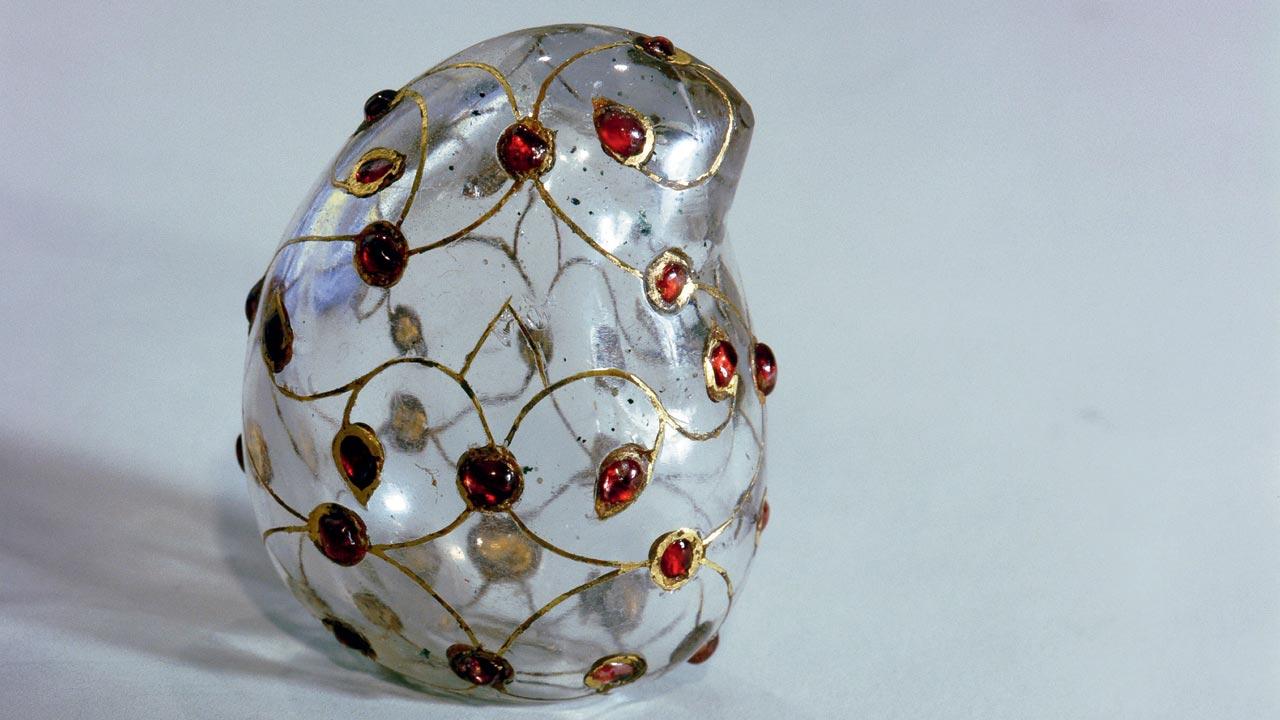From the mango flower in Kamadeva’s arsenal and Gandhi’s predilection for the fruit to the theory that the desire for fleshy fruits is what drove primate evolution, a new book promises to take readers beyond aam debates

Eleven thousand Alphonso mangoes are offered to lord Ganesha at the Dagadusheth Halwai Ganesh temple in Pune on the occasion of Akshay Tritiya. For the book, Joshi met Mandar Desai of Desai Bandhu Ambewale, which has extensive orchards in Ratnagiri, and a thriving retail and wholesale business in Pune, and is the firm responsible for decorating this iconic Pune mandir with 11,000 mangoes each year. Pic/Getty Images
The mango is the only fruit used to run down other regions and its people. You cannot insult anybody else’s culture by insulting their grapes or oranges or bananas,” Delhi-based journalist and author Sopan Joshi tells us, pointing to both the fruit’s dominance in the popular imagination and the worn-out conversations around the fruit that he hoped to go beyond.
ADVERTISEMENT
His new book, Mangifera Indica: A Biography of the Mango, a product of ‘slow journalism’ which Joshi espouses, is an ambitious project that shows how multiple disciplines—history, science, ecology, economics, and culture—bear on an understanding of the fruit. Joshi has lived with the story of the mango for close to a decade for this book. Among the more surprising discoveries he made during the course of his research was that for one, there are two distinct cultures of the mango in India. One, of the ordinary people who grew seed-grown mangoes on common land. In all Indian traditions, the forest is central. So, this was the wild mango. Second, there were the vatikas or panchavatis which were the pleasure gardens of the rich. “The mango’s horticulture changed significantly with the coming of Babur, founder of the Mughal dynasty. He came from a completely different ecological landscape—Central Asia is right in the middle of Iran and China, both ancient gardening powerhouses. That approach to horticulture prized controlled improvement. It was very different from traditional sub-tropical ideas of horticulture in India, rooted in an embrace of wilderness and uncertainty. This resulted in the addition of a new layer in India’s culture of the mango, with a sharper focus on the fruit,” Joshi tells mid-day.
 A rock crystal lime box in the shape of a mango, set with rubies inlaid in gold, dating back to the Mughal era of late 17th century. Pic/Getty Images
A rock crystal lime box in the shape of a mango, set with rubies inlaid in gold, dating back to the Mughal era of late 17th century. Pic/Getty Images
The Portuguese also arrived in Goa with cutting-edge horticultural skills. There was a great emphasis on fine mangoes or table-type mangoes which are cut and eaten, and that Mughal obsession got transferred to Indian merchants and rulers. Rich families who owned orchards began to employ mango managers. But Mughal rule did not undermine the desi culture of the amrais or mango groves. That was destroyed under British rule.
“A sizable proportion of orchards producing mangoes today were set up after Independence. They were a way to defeat land ceiling laws brought in for land redistribution after the abolition of zamindari. The ceiling on horticultural land was much higher than that for cultivable land with irrigation. Since land is a state subject, each state had its own laws. Most states with thriving horticulture had ceiling exemptions for orchards. Many families with large landholdings converted irrigated lands into mango orchards to dodge land ceiling laws.
Land is a fixed asset; nobody wishes to lose it, even if they have no interest in its productivity. This is the most serious threat to India’s mango sector. Most landowners are ‘absentee landlords’; in many instances, they don’t visit them even once a year. They ‘sell’ the mango crop in advance to contractors, who manage the orchards. So, the actual grower is a desperate contractor who’s forced to resort to a string of crude practices to make a profit. This is why the mango that we get today is actually quite poor. The fruit that is the cynosure of India’s cultural life is grown amidst overwhelming indifference,” Joshi says.
‘Marathi brides returned to maher during mango season’
 Sopan Joshi
Sopan Joshi
Mishra [Anupam Mishra, a scholar of socio-environmental traditions of ordinary people] was my mentor; I was still in school when I first travelled with him to see rural India. Among trees planted around water bodies was the mango; ancient texts such as Varahamihira’s Brihatsamhita list the mango as one of the trees to provide shade around ponds. It’s not just stray sightings or textual evidence. Older relatives have recounted to me the wedding parties of their childhood. The baraat, a contraction of the Sanskrit “var yatra” or the groom’s travelling party, stayed in mango groves outside the bride’s village. The lodging area was made comfortable and pleasant by the bride’s family, with food and entertainment. ‘They were charming, idyllic gatherings,’ an uncle had told me.
Many tribal villages in coastal Andhra Pradesh still have localities called vantalamammidi; it means ‘mango kitchen’. ‘These were mango groves under which travelling parties could take refuge and cook,’ said Ravi Rebbapragada, tribal rights activist in Visakhapatnam. Long before concrete banquet halls began to lend a grotesque touch to wedding arenas, the appropriate venue for a banquet was the mango grove.
In Amravati, Karuna Futane recalled her youth: ‘When I got married, it was the norm for the bride to go back to her parents during the mango season; the festival was called maher vashin (literally, living at mother’s house).’ She usually spent the mango season at her mother’s and recalled the excitement of plucking raw mangoes for pickles. ‘Good pickling mangoes were shared and sent all over,’ she said, her face flushed like a new bride’s, even as her granddaughter tugged at her sari. Her husband Vasant is a campaigner for natural farming. ‘In his youth, he used to plant mango trees by the roadside, saying it would give shade and fruits to passers-by,’ she said. In Nagpur, reputed Marathi playwright Mahesh Elkunchwar recounted his childhood in Parwa village of Vidarbha, surrounded by mango groves. As an adult, whenever he went back, he noticed the groves were gradually getting cut down. Now, they are all gone.
Mishra had heard about a mango grove in the region south of the Narmada River that was a makeshift hockey stadium. The central part with the hockey pitch was open ground, surrounded by mango trees that provided shade to spectators. Enquiries after its location have been fruitless. He also spoke of a mango grove set up by a community of hijras (transgender persons). It was called Hijdon Ki Amrai near the town of Narshighpur in Madhya Pradesh. After I tracked down their residence near the old part of the town, the transgender persons took me north along the Jhirna Road. Here lies a graveyard surrounded by 13 grand mango trees, where the community bury their dead.
One time, I happened to be travelling through Sohagpur, a town 120 kilometres west of here. I heard of a well-known face from the hijra community called Ghanshyam Guru. In 2010, Ghanshyam Guru embraced Islam and became Mohammed Haneef, undertaking Haj a few years later. Hindu cremation grounds here do not allow last rites for the hijra community. Afraid that their souls will wander about after their bodies die, they embrace Islam for the dignity of a burial. ‘The almighty is the one and the same, regardless of your mode of worship,’ she told me. The community held large parcels of land in this region, granted to them for sustenance by big landholders or the village leadership. Such lands frequently had mango groves as common resources.
Excerpted from Sopan Joshi’s Mangifera Indica: A Biography of the Mango published with permission from Aleph Book Company
 Subscribe today by clicking the link and stay updated with the latest news!" Click here!
Subscribe today by clicking the link and stay updated with the latest news!" Click here!







